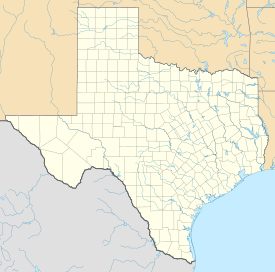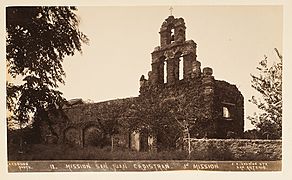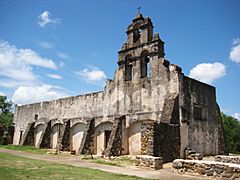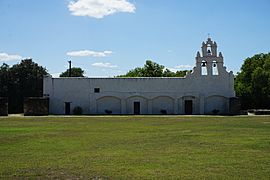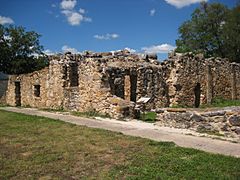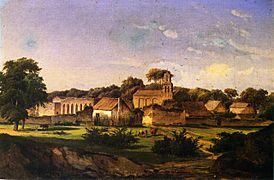Mission San Juan Capistrano (Texas) facts for kids
Quick facts for kids Mission San Juan Capistrano |
|
|---|---|
|
La Misión de San Juan Capistrano
|
|

The church of Mission San Juan Capistrano and its bell tower, called a campanario.
|
|
| Religion | |
| Affiliation | Roman Catholic |
| Location | |
| Location | San Antonio, Texas |
| Architecture | |
| Architectural style | Spanish Colonial |
| Completed | Founded 1731 |
| Criteria | Cultural: (ii) |
| Designated | 2015 (39th session) |
| Parent listing | San Antonio Missions |
| Reference no. | 1466-002 |
| State Party | |
| Region | Europe and North America |
| February 23, 1972 | |
| 72001352 | |
Mission San Juan Capistrano is a historic Spanish mission in San Antonio, Texas. It was first started in 1716 with a different name, but was moved and founded in its current spot in 1731. Spanish Catholic priests from the Franciscan Order built it on the San Antonio River.
The mission was part of a group of missions built by Spain in Texas. It was named after Saint John of Capestrano, a warrior priest and religious thinker from Italy who lived in the 1400s. Today, the mission is a World Heritage Site and part of the San Antonio Missions National Historical Park.
Contents
Building the Mission
When the mission was first built, its chapel (called a capilla) was a simple building made of brush and mud. Later, a bell tower (campanile) with two bells was added. Around 1756, this was replaced by a long building used for storing grain, which had a flat roof and a nice belfry.
Around 1760, the priests started building a bigger church, but they never finished it because there weren't enough workers.
Life at the Mission
Mission San Juan wasn't as wealthy as other missions in San Antonio. It didn't have enough land for large farms or for raising many horses and cattle. To get water for their crops, they built a dam and an irrigation system called an acequia. In 1762, the mission owned about 1,000 cattle, 3,500 sheep and goats, and 100 horses.
In 1756, about 265 Native Americans, mostly from the Coahuiltecan people, lived at the mission in huts made of adobe (sun-dried brick). By 1790, they lived in stone buildings, but their population had dropped to 58. It was sometimes hard for the priests to get the native people, who were used to a nomadic (traveling) lifestyle, to stay at the mission.
A Time of Change
On July 14, 1794, the mission was "secularized." This means it was taken from the control of the church and given to the local government. After this, a priest from the nearby Mission Espada would visit to hold services.
For many years, Mission San Juan was mostly abandoned. But in 1840, priests began holding religious services there again. A neighborhood grew around the mission, and some of the people who lived there were descendants of the original Native American families. In 1967, the Franciscan priests returned to take care of the mission.
Missing Historical Statues
Sometime between July 31 and August 1, 2000, three historic statues were taken from the mission's altar. The statues were made of carved and painted wood and were about 3 to 4 feet tall.
These statues were from the Spanish Colonial period, making them hundreds of years old. Because of their religious and historical importance, they are considered priceless.
Becoming a National Park
In 1934, workers uncovered the foundations of the unfinished church and some of the original living quarters. During the 1960s, the church, priest's quarters, and other buildings were rebuilt to look like they did long ago.
Since the 1980s, the National Park Service has taken care of the mission grounds as part of the San Antonio Missions National Historical Park. The church itself is still used for services and is managed by the Archdiocese of San Antonio.
Restoring the Mission in 2012
By 2012, the mission's church needed major repairs. The clay soil under the building was shifting, which caused large cracks in the walls. A $2.2 million project was started to fix the problem.
A new, deep foundation was built around the church to keep it stable. This allowed workers to remove the large supports that had been added to the outside walls in the 1900s. The outside of the church was also covered with a lime plaster, changing its color from a dark, old look to a fresh, eggshell white.
Gallery
See also
- List of the oldest buildings in Texas
- Spanish missions in Texas
- Mission Nuestra Señora de la Purísima Concepción de Acuña - also called Mission Concepcion
- Mission San José y San Miguel de Aguayo - also called Mission San José
- Mission San Francisco de la Espada - also called Mission Espada
- Espada Acequia


